North American FX study. (American secret projects: Fighters and interceptors 1945 - 1978 page 175).From Air Force 1968,
what was this ?.
Last edited:
North American FX study. (American secret projects: Fighters and interceptors 1945 - 1978 page 175).From Air Force 1968,
what was this ?.
Hi Jkeskir,North American FX study. (American secret projects: Fighters and interceptors 1945 - 1978 page 175).
Maybe the Fairchild 572A design?Hi Jkeskir,North American FX study. (American secret projects: Fighters and interceptors 1945 - 1978 page 175).
it's very similar,but it 's not exactly it ?.
Welcome aboard Dru2020,Maybe the Fairchild 572A design?
https://www.secretprojects.co.uk/threads/republic-aircraft-projects.10071/post-243260
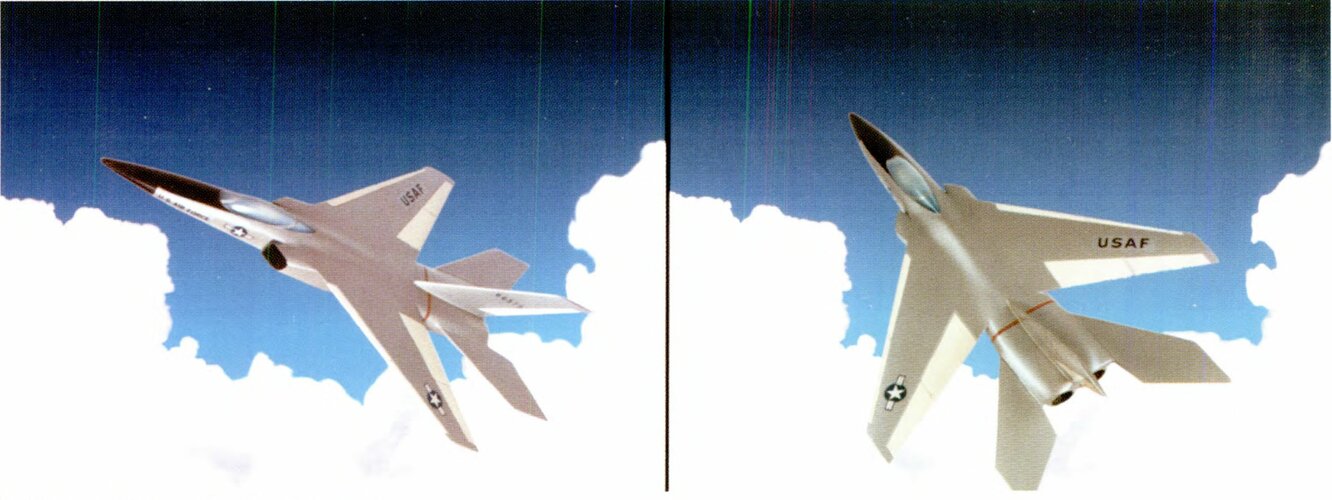
One of the most notable combat aircraft in which Wright Field's design engineers played a leading role was the F-X, which became the F-15. In-house design and analysis studies were conducted under the direction of Fred D. Orazio, Deputy for Studies and Analysis, in the mid-1960s. Under Orazio's guidance, the deputate undertook three related efforts: F-X point design studies; a tactical air-to-air capability study for the Tactical Air Command (TAC); and cost/effectiveness analysis for the F-X point design. Aircraft tradeoffs included a fixed-wing design versus a variable sweep wing; radius versus maneuverability; and radius versus Mach number. The Air Force chose the fixed-wing concept developed by McDonnell Douglas, whose design was very close to that developed by Orazio's group.

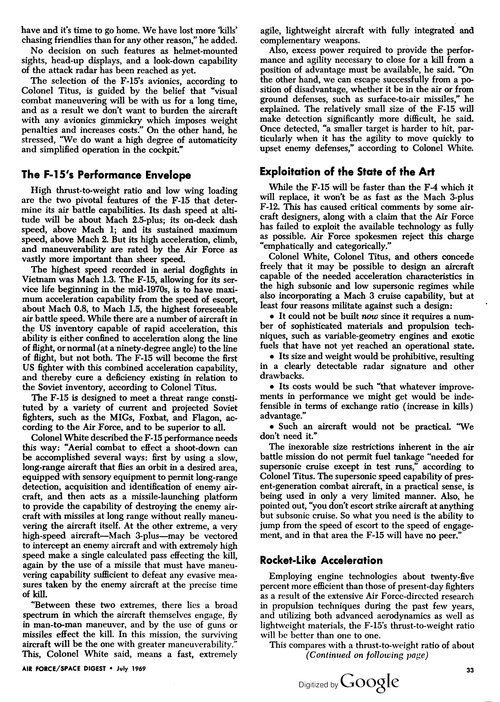
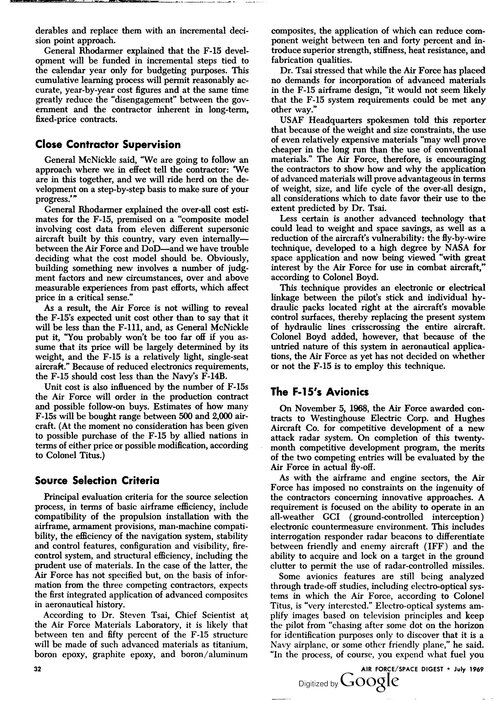

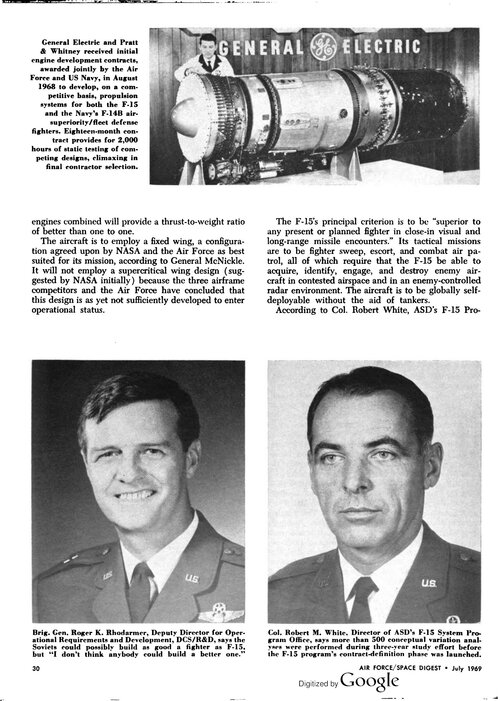
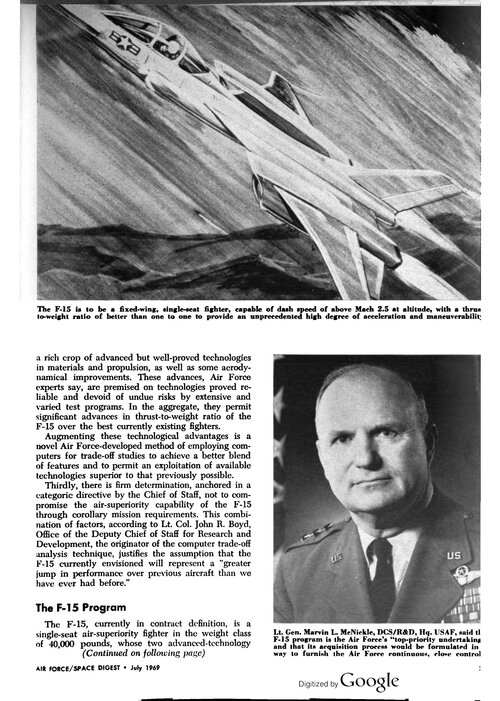

"The AIM-82 was part of a triumvirate of new weapons being developed by the USAF in the late 1960s, along with the Philco-Ford GAU-7 cannon (chambered for a new proprietary, caseless, telescoped 25 mm shell), and the AIM-97 Seekbat (a long range radar-guided air-to-air missile). It was envisioned that these would become the primary weapons of a new generation of fighter aircraft also under development at the time, the FX (short for "Fighter Experimental"), though the FX was also planned to use AIM-7 Sparrows as an interim while the AIM-97 was under development."
Given that 1969 article above mentioning the Sparrow as the "short-range dogfight" option for the F-X's armament? I'd say it's at least something to not dismiss out of hand.Just by chance, I stumbled across the following, whilst trying to find infomation on USAF's computer simulation ‘TAC Avenge' - FX armed with Aim-82 vs MiG-21 and achieving a 955-to-1 kill ratio....., so as to gain Congressional support for the FX and Aim-82......:
"The AIM-82 was part of a triumvirate of new weapons being developed by the USAF in the late 1960s, along with the Philco-Ford GAU-7 cannon (chambered for a new proprietary, caseless, telescoped 25 mm shell), and the AIM-97 Seekbat (a long range radar-guided air-to-air missile). It was envisioned that these would become the primary weapons of a new generation of fighter aircraft also under development at the time, the FX (short for "Fighter Experimental"), though the FX was also planned to use AIM-7 Sparrows as an interim while the AIM-97 was under development."
(Source: https://www.military-today.com/missiles/aim_82.htm)
Does anyone have anything else on the notion/intent of the AIM-97 Seekbat being intended as the prime weapon of the FX/F-15 and the AIM-7 Sparrows as an interim weapon?
Also, if I may, can anyone please give me the name/designation of the cancelled built-in IRST sensor that was intended to equip the FX/F-15 please?
Regards
Pioneer
The FX's "ATAR" was more telescope than IRST, much like the F-4E's TISEO and the F-14's TCS, it was slaved to radar for visual ID and had a secondary duty with optical A-G ordnance like Maverick and HOBOS. Paul's post on the ATAR page shows the system mounted in a pop up style in front of the windscreen with electronic boxes.Also, if I may, can anyone please give me the name/designation of the cancelled built-in IRST sensor that was intended to equip the FX/F-15 please?
Yes we have overscan and many thanks. But for the life of me, I couldn't remember the name of it, so as to search for itWe discussed it before = ATAR *was* TISEO/TCS effectively
It's mentions using the AIM-7 as an interim long-range AAM whilst the AIM-97 Seekbat, a long-range AAM based on the Standard Missile, is developed.Given that 1969 article above mentioning the Sparrow as the "short-range dogfight" option for the F-X's armament? I'd say it's at least something to not dismiss out of hand.Just by chance, I stumbled across the following, whilst trying to find infomation on USAF's computer simulation ‘TAC Avenge' - FX armed with Aim-82 vs MiG-21 and achieving a 955-to-1 kill ratio....., so as to gain Congressional support for the FX and Aim-82......:
"The AIM-82 was part of a triumvirate of new weapons being developed by the USAF in the late 1960s, along with the Philco-Ford GAU-7 cannon (chambered for a new proprietary, caseless, telescoped 25 mm shell), and the AIM-97 Seekbat (a long range radar-guided air-to-air missile). It was envisioned that these would become the primary weapons of a new generation of fighter aircraft also under development at the time, the FX (short for "Fighter Experimental"), though the FX was also planned to use AIM-7 Sparrows as an interim while the AIM-97 was under development."
(Source: https://www.military-today.com/missiles/aim_82.htm)
Does anyone have anything else on the notion/intent of the AIM-97 Seekbat being intended as the prime weapon of the FX/F-15 and the AIM-7 Sparrows as an interim weapon?
Also, if I may, can anyone please give me the name/designation of the cancelled built-in IRST sensor that was intended to equip the FX/F-15 please?
Regards
Pioneer
AWST 13 Jan 1969F-15 Weapons Mix Planned To Insure Air Superiority
USAF’s proposed F-15 tactical fighter will be armed with a mix of air-to-air weapons, including a still-undeveloped short-range missile, to insure its air superiority role at low and medium altitudes. The aircraft, formerly designated FX, is slated to carry four Raytheon AIM-7F radar-guided Sparrow missiles plus an internal cannon. Current plans call for the F-15 to carry the AIM-82 short-range missile (SRM), configured as a “dogfight” weapon, capable of withstanding high g-loads and striking sharply maneuvering targets at ranges well under 2 mi.
Three aerospace companies—Mc-Donnell Douglas, North American Rockwell and Republic Aviation Div. of Fairchild Hiller—recently were chosen by USAF to conduct competitive contract definition phase studies of the aircraft (AW&ST Jan. 6, p. 31). Air Force delayed its plans to begin competitive industry studies of the SRM last summer, and may not issue proposal requests for the weapon until late in the winter. One factor complicating SRM design is uncertainty about F-15 configuration and how the missiles are to be mounted.
If the missiles are semi-submerged in the airframe, as seems likely, this would preclude the weapon from locking onto the target until after it is released. That would make television guidance, one of two choices, difficult to achieve. One airframe manufacturer bidding on the F-15 has proposed a weapons mix of two Sparrows and four SRMs, placing two SRMs in each of two vacant Sparrow wells.
USAF has emphasized that provisions must be made to permit the pilot to engage in combat in a headup mode. This will require that a television guidance presentation be projected on a headup display if the missile is TV guided. The alternate is an infrared guidance seeker, like those in the Philco/ Raytheon Sidewinder and Hughes Falcon, which the SRM would supplant. Probable competitors for SRM development include General Dynamics, North American Rockwell, Hughes Aircraft, Philco and possibly Ling-Temco-Vought.
USAF is insisting that the air-superiority role of the single-seat F-15 not be compromised. It will be powered by 22,800-lb.-thrust turbofan engines with afterburner being developed competitively by General Electric and Pratt & Whitney (AW&ST Sept. 2, 1968, p. 16).
The engines are to have an extremely high thrust-to-weight ratio possibly as much as 8.3 at sea level. The aircraft is to have a range in its air-superiority role of 260 naut. mi. For point intercept, range will shrink to 125 naut. mi. In a high-low-high profile, range is expected to be 600 naut. mi. For ferrying, it can be stretched to 2,600 naut. mi.
Speed Goal
Design aim is a maximum continuous speed at altitude of Mach 2.3, with Mach 2.5 in bursts. On-the-deck maximum velocity will be about Mach 1.2. Whether the F-15 will be of fixed wing or variable-geometry planform awaits the outcome of Air Force’s current contract definition phase studies.
If a fixed-wing design favored by Tactical Air Command is chosen, takeoff gross weight probably will be about 42,000 lb. Maximum weight for variable sweep is likely to have a ceiling of about 44,500 Ib.
The aircraft is to be outfitted with a multi-mode pulse Doppler attack radar capable of automatically detecting targets at ranges of about 45 naut. mi. The 600-Ib. radar will lock onto targets at approximately 10 naut. mi. Westinghouse and Hughes are conducting competitive 20-month developments of the radar under USAF contracts totaling $22 million (AW&ST Nov. 11, 1968, p.30).
Anti-Radar Gear
The F-15 will be fitted with a radar homing and warning system and will be capable of accepting any number of active electronic countermeasures sets to combat specific anticipated radar threats. Air Force is expected to push for maximum use of advanced composite materials, such as boron fibers, as well as titanium to keep the F-15 airframe weight under control. The structures probably will have a fatigue life well in excess of 3,000 hr.
This section is quite interesting. I’ve never heard of a TV-guided air-to-air missile.AWST 13 Jan 1969If the missiles are semi-submerged in the airframe, as seems likely, this would preclude the weapon from locking onto the target until after it is released. That would make television guidance, one of two choices, difficult to achieve. One airframe manufacturer bidding on the F-15 has proposed a weapons mix of two Sparrows and four SRMs, placing two SRMs in each of two vacant Sparrow wells.
USAF has emphasized that provisions must be made to permit the pilot to engage in combat in a headup mode. This will require that a television guidance presentation be projected on a headup display if the missile is TV guided. The alternate is an infrared guidance seeker, like those in the Philco/ Raytheon Sidewinder and Hughes Falcon, which the SRM would supplant. Probable competitors for SRM development include General Dynamics, North American Rockwell, Hughes Aircraft, Philco and possibly Ling-Temco-Vought.
Thanks to Tony Chong's book Flying Wings and Radical Things, we can provisionally identify Northrop's FX study as the N310 Advanced Tactical Fighter of April 1968. It looks like an enlarged P530 Cobra of 62ft 5in length, and span 42ft 4in compared to 55ft 4in length and a 35ft span for typical P530 configuration. I disagree with Tony's suggestion it used GE15/J1A2 turbojets of 10,000lb - this would be quite clearly underpowered for such a large aircraft - but it was likely a GE1 core derivative in the turbojet/low bypass ratio turbofan configuration with 15,000 - 20,000lb thrust (possibly early GE15/J1A5 type).
Northrop formally declined to enter a bid for FX in the autumn of 1968 and instead teamed as subcontractor to North American Rockwell.
According to both Tony Chong and Tony Buttler, N310 was also known as P700 and eventually evolved into the N347 otherwise known as the Northrop/Dornier ND/102.
Current location: https://media.defense.gov/2012/May/16/2001330012/-1/-1/0/AFD-120516-036.pdfVery useful document -- thank you Overscan!
Hello paul, the link is not accessible, can you please provide a new access link?Apparently declassified only in 2008, here is
THE F-15 EAGLE - Origins and Development. 1964-1972 by Jacob Neufeld (OFFICE OF AIR FORCE HISTORY)
http://www.afhso.af.mil/shared/media/document/AFD-120516-036.pdf
It contains a table showing that Fairchild placed second in the competition.
Hello paul, the link is not accessible, can you please provide a new access link?
Apparently declassified only in 2008, here is
THE F-15 EAGLE - Origins and Development. 1964-1972 by Jacob Neufeld (OFFICE OF AIR FORCE HISTORY)
http://www.afhso.af.mil/shared/media/document/AFD-120516-036.pdf
It contains a table showing that Fairchild placed second in the competition.
Its a purely notional drawing of the FX / F-15 published by Air Force magazine.From Air Force 1968,
what was this ?.
